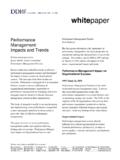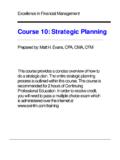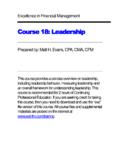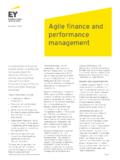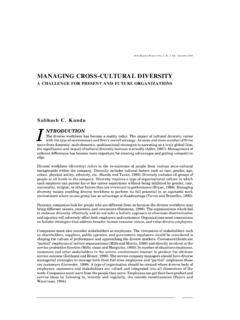Transcription of Steps to Creating a High-Performance Culture
1 By Gary Lear President & CEO Box 3185 Toll Free in the 888-909-6194 (386) 754-0920 Lake City, FL Fax (386) 754-0094 32056 Resource Development Systems LLC Managing the Human Side of Business SM Seven Steps to Creating a High-Performance Culture Most CEO s have heard about the benefits of having a strong Culture . What they are often left asking is how does our organization achieve this High-Performance Culture and reap the benefits that are so often talked about? We ve spent quite a lot of time researching just what it takes to create a Culture that will help an organization become high -Performing (see our related article The Dynamics of high Performing Organizations).
2 Here's what the research seems to support in regard to the Steps that need to be taken to successfully effect a Culture change in your organization: 1. It starts at the top. You have to have a leader (CEO, General Manager, Administrators, etc.) who wants to make this change. Research by John Kotter and James Heskett (Harvard University) shows that not one single effort at Culture change has ever been successful by starting at the bottom. It has to start with the very top and work down; not the very top, then to the bottom and back up again. 2. Measure the current Culture . This step and step 3 can be slightly interchangeable, but I prefer doing it at this point in time. You need a really good Organizational Culture assessment to find out what's going on in the organization. We're not talking about employee opinion surveys. We're talking about measuring the key things that go into Creating Culture , and that is: Trust levels in the organization; Employee Engagement levels; and Alignment on the Purpose, Vision, Values, and Goals of the organization.
3 3. Get top level buy-in to this change. The senior executive team must be in agreement and alignment with where the CEO is going to take the organization in this Culture change process, and they must support the efforts and the changes that will be occurring. I've seen too many organizations fail in their attempt because of this very issue. There are only three acceptable responses from senior management to the CEO's decision to move forward with Culture change: fully support; wanting more information but is supportive; or doesn't support and they are willing to leave on their own. Not speaking up and not supporting, or even sabotaging the change efforts are not acceptable, but too often are allowed to happen because up-front buy-in hasn't happened. 4. Clearly identify the organization's Purpose and Values, as well as begin to establish a Vision and Goals.
4 The Purpose is what will provide a direction for the organization, and the Values will provide the guidelines for accomplishing that Purpose. Everything else follows from there. Too many organizations just create Purpose (or Mission) and Values statements without any real understanding of why they are necessary and how they will insure that they live by the Values that they espouse. Failure to live by those very Values is a key component in destroying Trust in the organization. If Purpose is the direction, and Values are the boundaries, then Trust is the foundation for a successful Culture . 5. Communicate the intentions to ALL employees about where the organization (Continued on page 2) (Continued from page 1) is going and why it is taking these measures. Keep this positive. Keep Communicating! You need to be careful about this, as too many organizations have done things in the past to try to "reinvent" themselves and never followed through with it.
5 One gesture to show that you are serious this time might include tossing out your performance appraisal system as a start. Having a really good road map about where you are going and how you are going to get there is another. Your Culture change efforts should be well planned out in advance and you should have a good idea of what you are doing and why you are doing various things. 6. Start teaching your managers how to create the environment that will be necessary for your new Culture to be established, grow, and flourish. This means teaching them new ways of interacting with their employees, and new roles for them to undertake, forsaking other roles that are detrimental to the new Culture . Their goal should be to Build Trust within the organization. Building Trust is quite different from being trustworthy, and it's all too easy for management to do things that can easily destroy Trust, yet still think they are being trustworthy.
6 Just like most things, it's easier to tear down Trust than to build it. 7. Get everyone involved in being Personally Responsible for the success of the new Culture , not just top leadership or management. Push the levels of Personal Responsibility and decision making as far down the chain as possible. Let teams begin to manage themselves and make their own decisions about how they are going to accomplish things and meet their team's goals. Have clear cut measures of team performance that are clearly linked to the overall performance of the organization. Provide training to managers, supervisors, team leaders and team members on how they can become Self-Directed teams and individuals. This isn't a short term process. It will take most organizations about 2 to 3 years, maybe even a bit longer, to make this kind of transition.
7 It all depends on how serious the CEO is about making the change and how willing the organization is to devoting resources (time and money) to this endeavor, and, of course, how large the organization is. But the research is showing that there is a clear link to Creating this kind of Culture and increased profitability, sometimes as high as 700% or even more! In addition, employee engagement levels rise, and employee engagement levels have been clearly linked to productivity, profitability, employee retention, customer satisfaction and safety. It is clear that higher engagement levels result in a significant positive impact on the bottom line! So is taking the time and making the investment in Creating a Culture of High-Performance worth it? It is certainly hard work and takes a lot of focus to achieve a this type of Culture . But if you ask the CEO s of those organizations where they have made significant changes in their cultures, they would all say yes, it is worth it.
8 You just can t achieve the kinds of returns that are realized in any other way. Not only are those organizations that achieve High-Performance cultures seeing greater returns and profitability, but they are also better places to work, even for the CEO. Please see our previous articles on The Importance of Culture to Organizational Success, and The Importance of Trust to Organizational Success for more information on financial performance of organizations with high -performing cultures. 2004 Resource Development Systems, LLC Gary Lear is the President & CEO of Resource Development Systems LLC, a business consulting firm focused on helping organizations strengthen their cultures, engage their employees, and leverage the talents of their members to create the kinds of environments that lead to long-term organizational success and significance.
9 Contact Resource Development Systems, LLC for more information.
